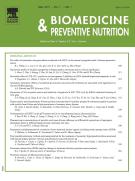Antioxidant capacities of polyphenols from Sumac (Rhus typhina L.) leaves in protection of erythrocytes against oxidative damage - 06/06/12

Abstract |
Rhus typhina L. (Staghorn sumac) originated from North America was introduced to Asia long since and was used for medicinal and food purposes. The present study was conducted to carry out the comparative analysis of antioxidant and free radical scavenging potential of water–acetone extract from Sumac (R. typhina L.) leaves and its main component -3,6-bis-O di-O-galloyl-1,2,4-tri-O-galloyl-β-D-glucose (C55H40O34) in defense of erythrocytes membrane against oxidative stress. The radical scavenging activity of the water–acetone extract from R. typhina L. leaves and its main component was studied using a direct reaction with a stable radical: DPPH· and ABTS•+. It was established that the rankings of EC50 values in the DPPH· and ABTS•+ assays was next off: C55H40O34>trolox>extract. We have shown also that both the extract and its main component effectively protect proteins and lipids of the erythrocyte membrane against oxidation induced by t-BuOOH in the presence of Fe2+. As in the direct reaction with a stable radical the effect of the extract on biological membranes was stronger than the effect of the main component. These data confirm synergetic action components of water–acetone extract from R. typhina L. leaves. This study provides a basis for the ethnomedical claims that R. typhina L. leaves extract may be effective against diseases with a defining role of oxidative stress in their pathogenesis.
Le texte complet de cet article est disponible en PDF.Keywords : Rhus typhina L., Tannins, Antioxidant activity, Metal chelating, Radical, Scavenging, Erythrocytes membranes
Plan
Vol 2 - N° 2
P. 99-105 - avril 2012 Retour au numéroBienvenue sur EM-consulte, la référence des professionnels de santé.
L’accès au texte intégral de cet article nécessite un abonnement.
Déjà abonné à cette revue ?

